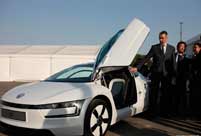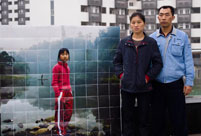 |
| Photo provided to China Daily |
Dutch designer Daan Roosegaarde is building a giant "electronic vacuum cleaner" — the world's largest air purifier — to suck smog from Beijing's skies.
It could turn a 1 kilometer diameter ring of poisonous haze into a 1-centimeter-diameter ring of a condensed particulate that people could wear.
Roosegaarde said the condensed smog "gets squished together" and turns into a sort of gel that can be fashioned into jewelry.
"The smog ring is one example of many possibilities," he told China Daily.
While the particles would be toxic to inhale as particulates, they would be safe to wear on a person's finger as concentrates, he said.
The vacuum is a mass of underground copper coils that generate an electrostatic charge that draws in smog particles.
"It's a similar principle to if you have a statically charged balloon that attracts your hair," Roosegaarde told Dezeen Magazine.
"If you apply that to smog to create fields of static electricity of ions, you literally attract or magnetize the smog so it drops down and you can clean it. It's like an electronic vacuum cleaner."
Roosegaarde told Dezeen that he had the idea for the project while staying at a hotel in Beijing and looking at the CCTV building from his window. "I could see the CCTV building," he said. "I had a good day when I could see it and I had a bad day when I could not see it. On a bad day the smog is completely like a veil. You don't see anything. I thought, that's interesting. That's a design problem."
"We've been working on a series on interactive landscapes," said the designer whose previous creations include dance floors that produce electricity from the people strutting their stuff on them and "smart highways" that generate their own light.
"We thought it would be interesting to use smog as a design component."
Roosegaarde has already developed a prototype and plans to install the first machine within in a little over a year, hopefully in a Beijing park.
But while the technology might appear to suggest a paradigm shift to blue skies, Roosegaarde believed it is no panacea.
"It's not the answer to smog," he said. "But it's making people aware there are solutions. The solution to smog is human, not technological. We should change the way we behave."
 Annual airshow kicks off in Houston
Annual airshow kicks off in Houston U.S. Navy Carrier Strike Group stages military exercises
U.S. Navy Carrier Strike Group stages military exercises Volkswagen showcases new energy vehicles in Beijing
Volkswagen showcases new energy vehicles in Beijing  Different eye catching shows at housing fairs in China
Different eye catching shows at housing fairs in China Special family portraits call attention to left-behind children
Special family portraits call attention to left-behind children Migrant children’s pain and joy in city
Migrant children’s pain and joy in city Lingerie show dazzles Wuhan Motor Show 2013
Lingerie show dazzles Wuhan Motor Show 2013  Running in fun customs at Beijing Int'l Marathon
Running in fun customs at Beijing Int'l Marathon  Weekly Sports Photos
Weekly Sports Photos Unveil PLA air force base
Unveil PLA air force base  World has never been dark-- a blind kid’s life in Tibet
World has never been dark-- a blind kid’s life in Tibet Oriental education or western education?
Oriental education or western education? China in autumn: Kingdom of red and golden
China in autumn: Kingdom of red and golden Pet costume competition
Pet costume competition Chinese screen goddesses from Beijing Film Academy
Chinese screen goddesses from Beijing Film Academy Day|Week|Month